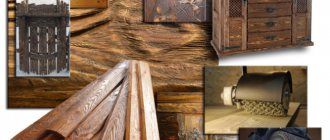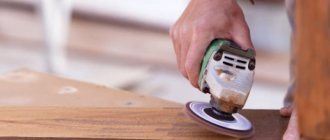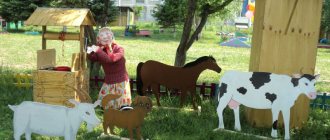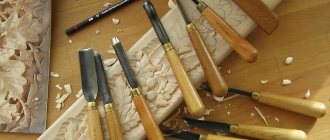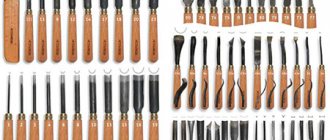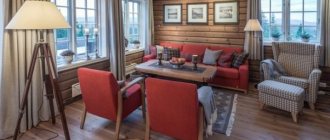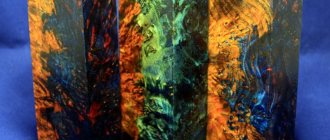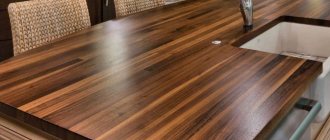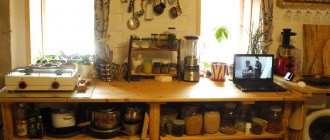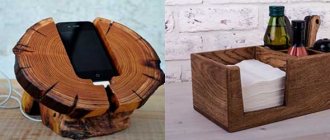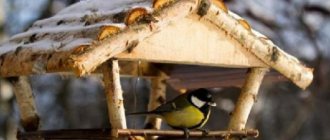Hardly anyone can confidently name the period in which products made from wood appeared. It is known that initially craftsmen created idols depicting animals or heavenly bodies. Wooden figurines mainly served as talismans. And today craftsmen continue their craft - wood carving.
When creating animal figures from wood, theory is not enough; the work requires experience. Masters recommend starting with simple samples. Familiarize yourself with materials and tools, make a blank from plasticine or clay. After mastering the basic techniques of carving, begin creating figures from wood. They create comfortable working conditions. The table should be comfortable and there should be sufficient lighting. For safety, the workpiece is fixed with a workbench.
Material selection
The quality of the finished product depends entirely on how well the material is chosen. The main types of wood used for work are:
- linden;
- aspen;
- birch;
- pine;
- oak or ash;
- alder;
- apple or pear tree;
- maple;
- rowan;
- larch;
- juniper.
Beginners are recommended to make their first wooden figures from linden . The material is easy to cut and does not form cracks. Large sculptures are created from aspen, as it is characterized by chipping. Birch has an unusual topography. For fine carving and creating decorative elements, walnut will be indispensable. Do not start working with the material until it is dry. The workpiece is wrapped in polyethylene and sent to a warm place.
Carving process
Preparing for work
When we have acquired everything we need, we can begin to master the technique of cutting out figures with our own hands.
However, first we take up not the knife, but the pencil:
Sketch of a Rhine Owl
- We make several sketches on a sheet of paper, drawing the main elements of our future figure. It is experienced craftsmen who can work “from the material” - but for us at first it is advisable to have a pre-thought-out sketch.
- If possible, we divide the future figurine into several parts, which can then be assembled on pins. Very often, long tails of animals, limbs located perpendicular to the main plane, etc. are cut out using this method.
Sketch, plasticine model and mold preparation
- Then we take the blank and mark on it the main parts of the future figure. Of course, there is no need to completely transfer the drawing, but the main lines should be before our eyes.
- Then we cut off the parts of the workpiece that will not be used in the work.
Important! Do not cut off the excess exactly along the border of the sketch. As a rule, craftsmen leave parts of the wood at the edges and cut them down last from an almost finished product - this makes it much more convenient to hold the figurine while carving.
Roughing
The roughing instructions will be as follows:
- First, we cut off or saw off all the parts from the workpiece that will extend beyond the figurine. Our task is to obtain a simple geometric shape that repeats the contours of the future product.
Tool characteristics
To create wooden figurines, use the following equipment:
- A knife with a short and beveled blade. The cutter cuts out large and small parts, and makes carvings in places where access is limited.
- When creating ornaments, they work with a blunt knife.
- Flat, semicircular or curved chisels are used to form recesses.
- Small details are cut out with chisels equipped with a spear-shaped blade.
Knives are kept sharp at all times, as precision is required when carving wood. When sharpening blades, they work with specialized whetstones or coarse sandpaper. A leather belt is used to straighten equipment.
. Carvers also work with a drill, sander, saw, mallet, rasps and sandpaper.
Execution of the workpiece
Initially determined by the size of the product . Knots are used to create small figures. Life-size figures are obtained from the deck. Craftsmen carve a garden gnome from a log without much effort. Large-scale sculptures are created from massive logs. Damage and chipping are not allowed on the workpieces. For those who plan to create wooden figures with their own hands, wood carvers recommend initially working with rectangular bars, since it is easier to apply a design to such a shape.
Creating wooden figures
After selecting the material and preparing the tool, they begin to work. Wooden figures are created by performing the following steps:
- Draw a sketch. A sketch of the animal is drawn on a sheet of paper with a pencil. Masters recommend depicting front, back and side views.
- The drawing is transferred from tracing paper to a wooden block.
- Choose a tool depending on the shape of the animal.
- Using a hacksaw or hatchet, cut off excess material. This is done until the required shape is obtained from the block.
- Start cutting out small parts. To prevent mistakes, an outline is drawn onto the workpiece with a pencil.
- Using a carving knife, cut out each part of the figurine. For convenience, start working with the corners.
- By cutting off layer by layer of material, the workpiece is shaped.
- The recesses are worked out and the edges are formed.
Finish the work with sandpaper. Sand the fragments, which should be smooth. Using an abrasive, fur or scales are formed on the surface. To protect the finished wooden animal figure, it is treated with a special compound. Leave to dry.
Processing of figures
Finishing of products is carried out in different ways. They coat it with varnish, stain or use different techniques. You don’t buy stain; the solution is prepared at home. Water stain consists of water and iodine. Add a few drops of dye to the water. A brown tincture is prepared by adding a solution of potassium permanganate to water. To work correctly with stain, one layer of the product is applied to the block in a trial. Roughness will appear on the product after drying. Having eliminated the defects, the product is covered with another layer of stain, the figurine is fixed with varnish or boiled in oil.
Experts say that products made from valuable or beautiful species are not coated, but rather oil is applied. When working with ebony ebony, no coating is applied so as not to spoil the material. The figurine is polished using dry horsetail.
Video: DIY wooden figurines
Wooden figures of fairy-tale characters can decorate any garden plot. In principle, such products can be purchased in specialized stores, but they cost quite a lot. So it makes sense to work hard and cut out a few figures for your dacha or interior yourself - especially since after a little practice you will most likely get the hang of doing this at a fairly high level.
In our article we will tell you what you need to purchase to successfully make wooden figurines, and also describe the carving process.
With skill and due diligence, you can even achieve such beauty
Scenario for creativity
It’s good when you already have a secret idea on how to transform your garden, vegetable garden, or the area in front of your house. Figurines for the garden and vegetable garden, arranged according to your own scenario, will have a truly “fabulous” look.
You can choose one general direction or individually designate certain areas with your own plot.
Advice from professionals
Volumetric carving is the aerobatics of a carver. Of course, the master must have some artistic potential, flair, and taste. But even all this will not bear fruit if the specialist does not engage in technology and does not gain experience.
- read specialized literature, watch carefully and rewind master classes on the Internet;
- remember how to work with drawing tools - school experience will be useful, and geometric carving will increase the scope of your abilities;
- lay out tools correctly, have protective covers for them and remember safety precautions;
- take care of proper working lighting - you can’t think of anything better than natural light, the light should fall from the front and to the left;
- walk through the forest - find interestingly woven roots, twigs and branches there, they themselves will give you ideas for the next work;
- The most valuable wooden sculpture is considered to be the one that is not made from scratch, but is minimally supplemented with the author’s tools.
Your best assistant is practical experience. Start with the simplest animal figures; don’t be afraid of mistakes and the fact that it will be difficult to complete in one day.
How often, looking into someone else's garden, you can see garden decorations made of wood that serve as bird drinkers, feeders, or simply accents of garden ideas. Who doesn’t dream of decorating their dacha to the envy of their neighbors? Or just have an original keychain made of natural material on your keys? Some people pay money, while others want to not only save money on this, but also possibly make money.
Ancient Greece sculpture
Ancient Greece made a significant contribution to the development of world culture. The highly developed nature of ancient Greek sculpture made it possible to demonstrate a holistic and harmonious vision of the world by ancient people, to reflect the moral and physical perfection of man in a three-dimensional model.
Delightful statues, distinguished by their clarity and regularity of form, were carved from stone or limestone and decorated with precious stones and items made of precious metals. They were installed in temples and city squares, in the homes and on the graves of rich and famous Greeks.
The history of ancient sculpture is represented by several periods with exceptional and unique features.
Archaic (VII-VI centuries BC)
For sculpture in Greece during the archaic period, a distinctive feature is the appearance of a smile on the faces of statues, designed to spiritualize them, and the sculptures themselves increasingly correspond to the proportions of the human body. The idol began to be perceived as a generalized, collective image of a person.
A striking example of archaic female figures are the “Goddess with a Pomegranate” (580-570 BC) and the “Goddess with a Hare” (c. 560 BC). Among the male images, the sculptural group Kleobis and Biton, created by the famous sculptor Polymedes of Argos (at the turn of the 7th-6th centuries BC), stands out. And lightness, sophistication and cheerfulness distinguish the works of the ancient Ionian masters. The most famous example is considered to be “Apollo of Tenea”, created in 560-550. BC.
Monumental sculpture occupied a significant place in the art of that time. It was customary to depict the most interesting and significant myths of Ancient Greece on the relief. A careful examination of the composition of the pediment of the Temple of Artemis (circa 590 BC) allows you to enjoy the spectacle of the exciting, rapidly unfolding plot of the famous myth of Medusa the Gorgon and the glorious Perseus.
The end of the archaic and the beginning of the transition to the classical stage is associated with the appearance of such works as “The Horseman of Rampin” (about 560 BC) and the stele of Aristion (about 510 BC). They no longer have the rigidity characteristic of the creativity of the previous stage, but the movements are still quite constrained. Despite the presence of an archaic smile on the faces of the statues, the clear rendering of the plasticity of the bodies symbolizes the change in the ideals of ancient Greek sculptors, which will be reflected in the works of the classical era.
Master class on creating a cat figurine
If you are just trying your hand at carving and are not ready to take on a complex figure, start by making a wooden cat figurine. Even your first experience in carving will be successful.
Cat made of wood step by step:
- Draw a sketch - a simple image of a cat with an arched back. Cut out the design along the contour (it is more convenient to make a sketch on cardboard).
- The sketch needs to be transferred to the tree, simply tracing the cat along the contour. Then you need to cut the animal along this contour with a hacksaw.
- A chisel and mallet will help cut the shape. Rough processing completed!
In this case, the figurine is simple and does not require additional decoration. But a wooden sculpture can be painted with acrylic, decorated with rhinestones, etc.
LiveInternetLiveInternet
–Categories
- “RUSSIANS” – HISTORY AND MYTHS (122)
- “We” and “they” (5)
- From Slavic-Russian history (16)
- Russian clothes, kitchen, utensils, etc. (24)
- Russian faces (19)
- The way of Russian home and life. Customs. Traditions. (58)
- ARCHITECTURE AND DESIGN (264)
- Architects and buildings (48)
- Palaces and castles (112)
- Wooden architecture (28)
- Estates (25)
- Temple buildings (churches, monasteries, etc.) (54)
- CITIES AND COUNTRIES (471)
- Asia (48)
- Africa (6)
- Middle East (18)
- Europe (335)
- Oceania (Australia, New Zealand, etc.) (9)
- Post-Soviet world (28)
- North-South America and Canada (23)
- Cities and countries. RUSSIA. (122)
- Cities and villages of the Russian Federation (29)
- Moscow yesterday, today and tomorrow (49)
- Old Russian cities (44)
- DECORATIVE ARTS (200)
- Dolls (63)
- PAINTING (730)
- “National” types of painting (35)
- Watercolor (106)
- Graphics, computer painting and drawing (39)
- Illustrations (105)
- Impressionism and avant-garde (118)
- Curious stories (5)
- Palette knife (11)
- Naive painting (16)
- Wall painting (15)
- Still life (36)
- Landscape and floral painting (34)
- Realism, neo-realism, classicism (59)
- Russian realism (98)
- Symbolism (41)
- Surrealism. Orientalism. Fantasy. (42)
- MEDIEVAL, RENAISSANCE AND BAROQUE ART (25)
- STORIES AND PEOPLE (242)
- History and stories (33)
- Monarchies and aristocrats (141)
- About what makes us human (12)
- Political and religious figures (7)
- Creative and enterprising individuals (50)
- MUSEUMS AND LIBRARIES (33)
- MUSIC AND DANCE (132)
- Vocalists and singers (20)
- Composers (28)
- Musical works (42)
- Musicians (17)
- Miscellaneous (3)
- Dance and dancers (24)
- SCIENCE AND FICTION (87)
- SOME RECIPES (13)
- PARKS. GARDENS. RESERVES. (147)
- USEFUL (21)
- HOLIDAYS AND FESTIVALS (25)
- SCULPTURE. FIGURINES. (101)
- Monuments (11)
- FUNNY AND WITTY (38)
- THEATER AND CINEMA (87)
- Theater interiors (13)
- POINT OF VIEW AND SMART THOUGHTS (18)
- FLORA AND FAUNA (132)
- Butterflies and birds (21)
- Everything that grows and blooms (73)
- Cat dogs and other cuties (38)
- PHOTOS AND VIDEOS (82)
- Masters of photo and video (29)
- Old photos (15)
- Still life photographs (38)
- LANGUAGE AND ITS “VICTICISM” (12)
– Quote book
Evgenia Gorbacheva is the author of very interesting watercolors. In 2000 she graduated from art school.
Esionov Andrey Kimovich (born 1963) - painter and graphic artist, academician of the Russian Academy of Arts.
Odilon Redon (1840-1916) - French painter, graphic artist, decorator, one of the founders of the symbol.
Luxembourg Gardens is a palace and park ensemble in the center of Paris. Former royal, and now a sovereign.
Jessie Arms Botke (1883-1971) – American.
–Tags
–Search by diary
–Subscription by e-mail
-Statistics
Hellenism
The Hellenistic period is distinguished by the strong influence of the East on ancient Greece. The sculpture of this stage is characterized by the complication of angles, the use of luxurious draperies and the smallest details. All this is aimed at giving the works emotionality and temperament, completely uncharacteristic of the art of Ancient Greece in previous periods.
The most famous figures of the Hellenistic period are the statue of Aphrodite of Cyrene, imbued with sensuality, and the composition “Laocoon and His Sons,” filled with drama. Stunning accuracy and realism, as well as strong emotions, impress and fascinate modern audiences.
Ingredients for boletus mushroom
The following components are needed for manufacturing:
- half a kilo of gypsum material or cement mixture;
- construction PVA;
- varnish paint;
- enamel, for performing work related to coating glass and ceramics;
- pencil;
- compass;
- brushes;
- large needle, knife or woodworking cutters - your choice;
- ordinary cling film;
- empty bottle (plastic) of appropriate shape;
- a cup for casting the base and another for shaping the mushroom cap
- decor - beads, figures, leaves, flowers;
- glue for fixation (waterproof);
- soap, water, sunflower oil.
Leg
The neck of the bottle is cut off. This is the shape for the leg. The walls are covered with soap and water plus oil. Ratio 2:7:1. The emulsion is applied with a brush. The plaster is partially diluted in accordance with the attached instructions and poured into the mold.
To save money, you can insert a bottle into the solidifying mass and press it down with a press. Then the leg will become hollow. After about forty minutes, the workpiece hardens and is removed using a knife for further processing.
High Classic (late 5th century BC)
The classical era was represented by two main directions of ancient Greek art:
- Revealing the beauty of movement by the famous msculptors of Ionia and Attica. A well-known example of this trend is the statue of Nike Paeonius (460-420 BC)
- The combination of external rigidity of figures with the hidden movement of life by the masters of the Argive-Sicyon school. A striking example is the bronze "Doriphoros" of Polykleitos (circa 440 BC)
The great Phidias was able to combine the trends of both directions in his work. The Athenian Acropolis, the reconstruction of which he led, and the sculptures included in the ensemble can still be admired today. Not only their majesty and beauty are noteworthy, but also the fact that they fully convey the features of Phidias’ art. And individual creations, distinguished by the perfection of each line, reveal that the master himself had a hand in their creation.
The attention of everyone who enters the territory of the Acropolis is attracted, first of all, by the bronze statue of Athena Promachos, striking in its grandeur. Then the viewer begins to see many other details: the amazing statues and stunning reliefs of the Parthenon, the delightful metopes depicting the mythical history of Attica, the amazing frieze of the cella reflecting the procession of the Panathenaic.
The magnificent Parthenon demonstrates the highly developed nature of ancient Greek art, which made it possible to blur the boundaries of sculpture and architecture, combining them into one harmonious whole. In addition to plasticity and dynamics, in sculptures from the end of the high classical period, emphasis appears on the spiritual world of man.
Small shaped plastic decorations
One of the most common materials for crafts is ordinary plastic bottles of various sizes. They constantly accumulate, especially in the warm season.
If you apply a little imagination to them and use the services of a website that provides a sufficient number of interesting options, then you can successfully create a “small miracle” in your dacha space.
Plastic figurines for the garden are an excellent theme for decorating the landscape. They are light, not susceptible to damage by water and are in perfect harmony with the atmosphere of a country house mood. Bottles with a small volume, for example, can serve as a basis for bright working bees.
If you give them a striped yellow and black color and hang them on tree branches, the breeze will create a mesmerizing illusion of flight. For the antennae you will need a wire threaded through the cap.
An exotic “palm tree”, one or several, will turn a small space into a kind of island. The main material is plastic bottles. They are cut and inserted one into the other. Now the barrel is ready. Leaves are attached to the top. Green blanks from larger bottles. Beautifully place sand and stones under improvised “palm trees”. This will add African flavor.
